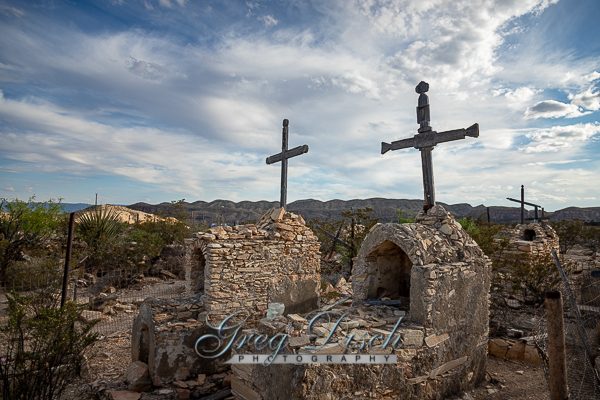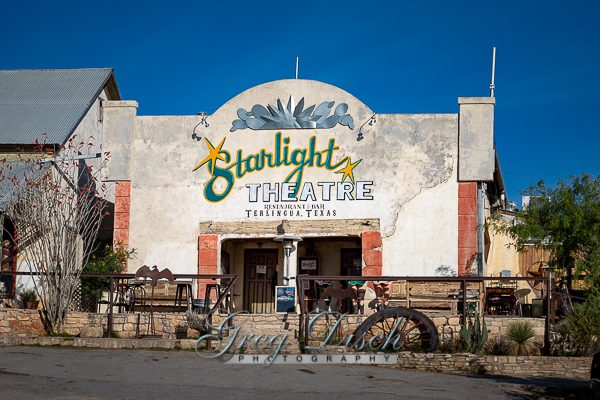Terlingua Ghost Town

Due to its proximity to Big Bend National Park, today Terlingua is mostly a tourist destination for park visitors. Rafting and canoeing on the Rio Grande, mountain biking, camping, hiking, and motorcycling are some of the outdoor activities favored by tourists. Much of the Ghost Town has been re-inhabited and there are restaurants and lodging available.
On the first Saturday of November, over 10,000 “chiliheads” convene in Terlingua for two annual chili cookoffs: the Chili Appreciation Society International and the Frank X. Tolbert/Wick Fowler World Chili Championship (established 1967).
The Chisos Mining Company, was established in 1903 at Terlingua . Founded by Howard E. Perry, a Chicago industrialist, the Chisos reported the first recovery in 1903, and during the next three decades became one of the nation’s leading producers of quicksilver. Initially the company processed the cinnabar ore in primitive retorts, where the silver liquid metal is recovered through a simple baking process. As production increased, Perry turned to more industrialized methods . Exploration continued, and in 1914 the company discovered one of the richest veins of cinnabar ore in the Terlingua district. This discovery coincided with the outbreak of World War I, and with the increased military demands for the product, the company entered its most successful period. Several factors contributed to the success. First, the property contained some of the richest ore in the quicksilver district; second; Perry engaged men of outstanding caliber to supervise the onsite operations ; third, quicksilver prices peaked during World War I, the period of the mine’s maximum recovery; and fourth, an abundance of cheap Mexican labor. The community of Terlingua grew up around the mine. Up to 2,000 inhabitants had access to facilities of modern civilization: a company-owned commissary and hotel, several excellent dwellings (for Anglo employees), a school, a company doctor, telephone service, a dependable water supply, and three-times-a-week mail delivery. Prior to the use of mechanized vehicles in the early 1930s, the mule-drawn wagontrains that delivered the quicksilver to the railroad at Alpine and Marathon supplied the
History
According to the historian Kenneth Baxter Ragsdale, “Facts concerning the discovery of cinnabar in the Terlingua area are so shrouded in legend and fabrication that it is impossible to cite the date and location of the first quicksilver recovery.” The cinnabar was apparently known to Native Americans, who supposedly used its brilliant red color for pictographs.
A man named Jack Dawson reportedly produced the first mercury from Terlingua in 1888, but the district got off to a slow start. The Terlingua finds did not begin to be publicized in newspapers and mining industry magazines until the mid-1890s. By 1900, four mining companies had recovered 1000 flasks in the district: Lindheim and Dewees, Marfa and Mariposa, the California, and the Excelsior. By 1903, they were joined by the Texas Almaden Mining Company, the Big Bend Cinnabar Mining Company, and the Colquitt-Tigner combine.
George W. Wanless and Charles Allen began working the area of California Mountain around 1894 based on reports of Mexican miners from as early as 1850. Ore was found in 1896. Jack Dawson, J.A. Davies and Louis Lindheim soon followed. A Terlingua post office was established in 1899 at the California Mountain mining community. The origin of the name Terlingua may be a corruption of Tres Lenguas, in reference to an early mine or local feature. By 1903, 3000 people populated the area. The mining center and post office eventually moved to the area of the Chisos Mine and the original settlement took on the name of Mariposa.
What to Photograph
There are many old ruins mixed in with restored or new buildings throughout the town. The Starlight Theater now a restaurant, St Agnes Catholic Church, and the Terlingua Cemetery are some great photo opportunities.
Where it is:
Terlingua is accessible from heading west on Highway 118 out of Big Bend National Park, or by traveling south on 118 from Alpine and turning west on Highway 170 also known as the River Road, rated as the #1 Scenic Drive in Texas. The road winds through high altitude with the iconic river, providing plenty of photo opportunities of the desert scenery and canyons passed along the way.

The cemetery dates from the early 100’s when Terlinqua became a flourishing mercury mining town. It served the district as the final resting place for residents and mine workers that succumbed to dangerous working conditions, gunfights, and the influenza epidemic of 1918. The Terlingua cemetery is still used by the local community-evidenced by the newer graves. Each November 2, people gather here to celebrate the Day of the Dead and offer their respect to the departed.
Interactive Google Map
Use the map + – controls to zoom in and out, click and drag the to move the map, use the Map drop-down to change to “Map”, “Satellite”, “Hybrid”, or “Terrain” views. Drag the little man icon from the upper left corner to a map location for street level view.
GPS:
29°19’9.923″ N
103°36’24.965″ W
Cost:
There is no cost to visit Terlingua
There are no hours to visit the Ghost Town and it is an excellent location for night photography.
Facilities:
Visitors will find a trading company/gift shop, art galleries, unique lodging options, restaurants, and bars.
Terlingua Ghost Town Photo Gallery
Click Here for full page gallery
More Photographic Destinations in Texas:
Interactive Google Map
Use the map + – controls to zoom in and out, use the Map drop-down to change to “Map”, “Satellite”, “Hybrid”, or “Terrain” views. Drag the little man icon from the upper left corner to a map location for street level view. Click on a pushpin for more information about the Photographic Destination, then click on the title to go to the location page.
Click Here for Photographic Destinations by State





